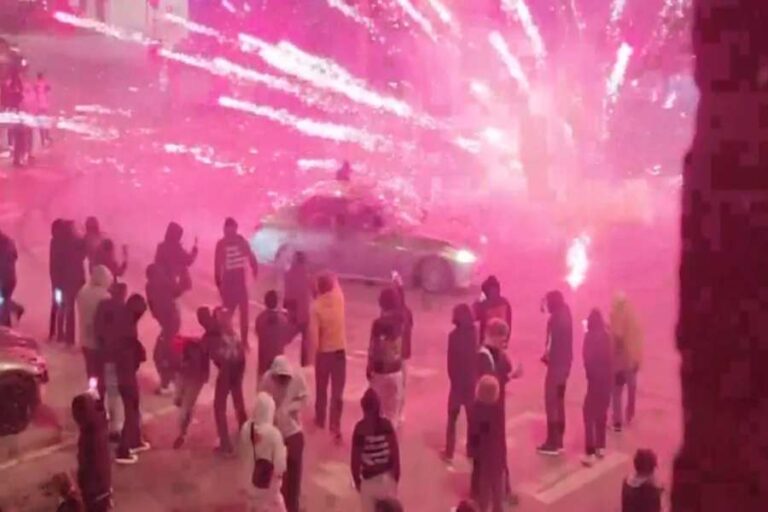A peaceful night in Chicago’s Lakeview neighborhood turned into a scene of chaos as cars spun wildly in the middle of intersections, fireworks lit up residential buildings, and stunned residents looked on in disbelief. This wasn’t a one-off event — it was yet another brazen street takeover, part of a growing trend that’s turning Chicago roads into stunt arenas, with little warning and fewer consequences.
The latest incident unfolded at the intersection of Ashland Avenue and Diversey Parkway. Videos from both witnesses and the participants themselves quickly spread across social media. In the clips, cars are seen circling at high speeds as passengers hang from windows, cheering and setting off fireworks that explode dangerously close to nearby buildings.
Residents like Anne Jewell were shaken awake by the noise. “I couldn’t tell if it was fireworks or gunshots,” she said. “It went on for what felt like forever. I don’t understand why this keeps happening. Why can’t they stop it?”
This takeover wasn’t isolated. A similar event took place that same night near Columbus and Lower Wacker Drives downtown. The repeat nature of these incidents is alarming residents and city officials alike, especially as warmer weather draws more crowds and encourages outdoor activity.
Alderman Scott Waguespack, who represents the 32nd Ward where the Lakeview incident occurred, said his office was flooded with calls as soon as the event began. “These events are quick, unpredictable, and extremely hard to control,” he explained. “And a big part of the challenge is that the drivers remove their license plates, making it nearly impossible to track them after the fact.”
Despite these hurdles, Waguespack noted that police are being urged to increase enforcement and use new powers granted to them by recent legislation. The city has modified laws to allow for vehicle impoundment in connection with street takeovers, even if the suspect isn’t caught behind the wheel at the scene.
“We changed the law so they can impound these vehicles,” he said. “That’s where we really need to double down. Make it so costly and inconvenient that they think twice before doing it again.”
When officers arrived at the Lakeview takeover early Sunday morning, the crowd quickly dispersed. Drivers peeled away into the night, leaving behind only burned rubber marks and a trail of viral videos. No arrests were made.
Waguespack said containment remains the top strategy for now. “We’re trying to keep these takeovers from spreading into more neighborhoods. Once they start moving around the city, it becomes even harder to respond.”
Street takeovers, once an underground phenomenon, have evolved into well-coordinated spectacles. Organizers communicate through private messaging groups and can mobilize dozens of vehicles in minutes. By the time authorities are alerted, the show is already underway — or over.
These events may last only minutes, but the impact lingers. Residents are left shaken. Intersections are damaged. City resources are strained. And the message being sent — that lawlessness can take over the streets without consequence — is deeply unsettling to many Chicagoans.
Jewell, still frustrated days later, says the lack of arrests feels like a failure of the system. “There are videos. There are people right there in the open. How can no one be held accountable?” she asked. “We just want peace. We want to feel safe.”
The city is stepping up its response. Waguespack says police are now coordinating with city departments to install more surveillance cameras in high-risk areas. Additional patrols are being assigned to neighborhoods that have seen repeat activity. The hope is to disrupt these events before they even start.
Yet, there’s a growing sense that more is needed — perhaps public awareness campaigns, community engagement, and stronger penalties for those organizing or attending these illegal gatherings.
With summer fast approaching, many fear things could get worse before they get better. Street takeovers thrive in the warmer months, when roads are dry and crowds are more willing to show up. For city officials, it’s a race against time to implement meaningful deterrents before the trend grows beyond control.
“We’re doing what we can,” Waguespack said. “But it’s going to take cooperation from the public, from lawmakers, and from every part of the city to really push back on this.”
As residents prepare for more possible disruptions, one thing is clear — the patience of neighborhoods like Lakeview is wearing thin. The demand is no longer just for response — it’s for results.
